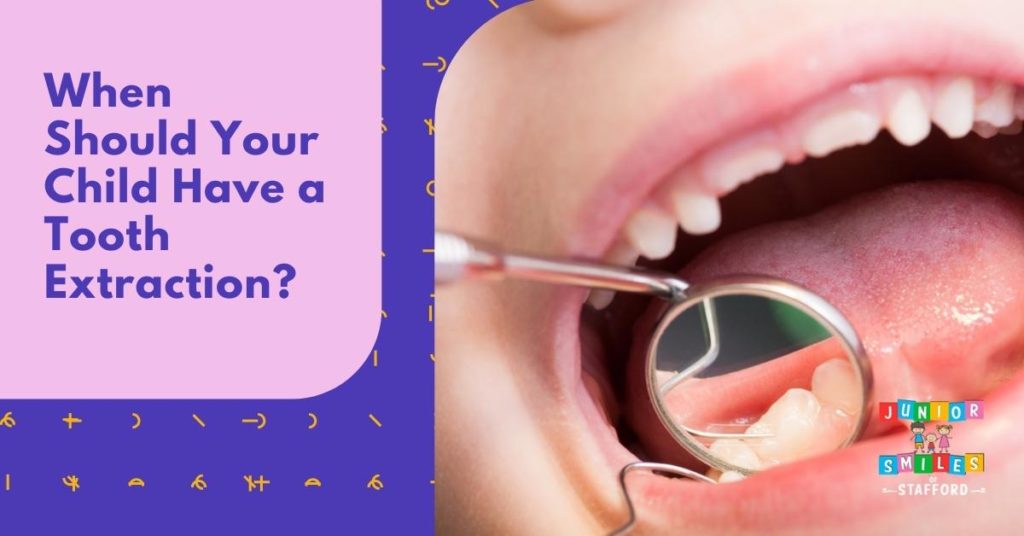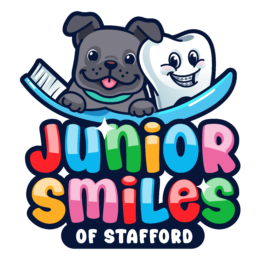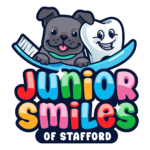When Should Your Child Have a Tooth Extraction?

Navigating the waters of parenting can often mean facing the unexpected, such as when your child may require a tooth extraction. This could range from dealing with extra baby teeth that may affect the eruption of adult teeth to handling the complications of Baby Bottle Tooth Decay. Understanding the intricacies, including when the removal of baby teeth is necessary and how permanent teeth are involved, can be essential for maintaining your child’s healthy tooth structure.
Why Might a Tooth Extraction Be Necessary for Your Child?
There are several reasons why your pediatric dentist might recommend a tooth extraction for your child. Here are a few circumstances that commonly lead to dental extractions:
Tooth Decay or Infection
If extreme tooth decay has compromised the healthy tooth structure beyond what fillings or crowns can repair, an extraction may be necessary. Infections in baby teeth can spread quickly, leading to more serious health issues if not addressed promptly. Early intervention with dental extractions can prevent these issues and protect the development of permanent teeth.
Over-Retained Baby Teeth
Sometimes baby teeth linger longer than they should, potentially leading to crowded teeth or impeding the proper eruption of adult teeth. Over-retained primary teeth can cause alignment issues that might require more extensive orthodontic treatment later on. It’s essential to monitor the timely loss of baby teeth to prevent over-retention that can complicate the emergence of permanent teeth.
Space Maintainers for Erupting Teeth
In cases where baby teeth are lost too early, space maintainers may be utilized to preserve the gap for the future permanent tooth. These devices help in preventing adjacent teeth from shifting into the space meant for the permanent tooth, which can lead to significant alignment issues. Timely use of space maintainers can ensure a smoother transition for the eruption of adult teeth, often reducing the need for complex orthodontic work in the future.
Orthodontic Reasons
Overcrowding can lead to the need for the extraction of certain baby teeth to provide room for the correct alignment of remaining teeth, especially when braces or other orthodontic devices are involved. Strategic removal of specific teeth by oral surgeons can be a proactive step in a comprehensive orthodontic treatment plan. This approach often helps in achieving the desired dental structure and a more functional bite.
How Are Children’s Teeth Extracted?
The process of extracting a child’s tooth is approached with extra care to minimize discomfort and anxiety. The pediatric dentist will start with a thorough examination, which usually includes X-rays, to assess the condition of the tooth, its roots, and the surrounding bone and gum tissue. This is crucial for planning the best course of action for the extraction.
Sedation and Anesthesia Options
If an extraction is deemed necessary, the dentist will then discuss sedation options. For many children, local anesthesia is sufficient to numb the area, but for those who are particularly anxious or where the procedure may be more involved, conscious sedation such as nitrous oxide (laughing gas) may be offered. This form of sedation allows the child to stay awake but feel relaxed and experience less pain during the procedure.
The Extraction Procedure
Once the child is comfortable and the area is numbed, the dentist will gently rock the tooth back and forth to loosen it from the jawbone and ligaments that hold it in place. For a simple tooth extraction, this is often all that’s needed. However, if the tooth is impacted or the situation is more complex, the dentist may need to remove some of the gum tissue or bone, or section the tooth into pieces to remove it with as little trauma to the surrounding tissue as possible.
Comfort and Reassurance During Extraction
Throughout the extraction process, the pediatric dental team will focus on keeping the child calm and comfortable, using a gentle approach and providing reassurance. After the tooth has been removed, they will give detailed aftercare instructions to ensure proper healing. This includes advice on diet, oral hygiene, and activities, along with what to expect in the following days. They may also discuss the placement of space maintainers if needed, to hold the space for the permanent tooth to come in, especially if a primary tooth has been removed prematurely.
Preparing for Primary Tooth Extractions
Understanding what’s involved in a simple tooth extraction can help ease your child’s and your anxiety. Oral surgeons and pediatric dentists are skilled at ensuring a comfortable experience, often using conscious sedation to help manage any discomfort.
What to Expect During the Procedure
Your child’s dentist will carefully evaluate the need for tooth extraction, often starting with X-rays to assess the situation below the gum line. If conscious sedation is used, it will be administered safely to minimize any anxiety and discomfort for your child during the procedure. In certain complex cases, like an involved tooth extraction, a referral to an oral surgeon might be the best course of action to ensure the highest level of care.
Essential Tips for a Smooth Pediatric Tooth Extraction Experience
Extracting baby teeth can be a frightening experience for children. The majority of the time, it’s a basic process. To make their experience more comfortable, your pediatric dentist will provide you with information about anesthetics and nitrous oxide. You and your child’s dentist will then go over what’s about to happen and address any questions they may have.
Here are some tips you can try for the best and quality pediatric tooth extraction:
Pick The Right Dentist
The first step in tooth extraction is to pick the right dentist. Make sure you choose a licensed dentist–a dentist that handles every child with care. And an office with amenities that are friendly to children; that way, they will feel more welcome and less scared of the orthodontic treatment.
Ask More About Sedation
It would be best to ask your dentist for advice when deciding about this as this also depends on your child’s age. Your dentist will provide you with sedation options to make the extraction process as painless as possible.
Follow Every Toddler Tooth Extraction Aftercare
After the tooth extraction process, make sure to ask all the tooth extraction aftercare questions that pop into your mind as this will help your child greatly. Your dentist will provide you with detailed and comprehensive post-extraction care instructions. Always check up on your child, and make sure they only consume soft foods and avoid straws for at least 24 hours.
Post-Extraction Care
The aftercare of a tooth extraction is crucial in preventing complications such as infection or delayed healing. Parents should encourage their children to drink plenty of water to stay hydrated, which aids the healing process, and avoid using straws in the immediate aftermath to protect the blood clot in the socket. Soft foods that require minimal chewing are recommended to avoid disturbing the extraction site, and following the dentist’s instructions on oral hygiene will facilitate a quicker recovery.
Baby Tooth Extractions and Healing
After a baby tooth extraction, the focus should be on keeping the area clean, managing discomfort, and monitoring the site for proper healing. It’s important for children to stay hydrated with plenty of water, as good hydration supports overall health and aids in the healing process. The dentist may suggest rinsing with a saltwater solution to keep the mouth clean, which is gentle on the extraction site and can reduce the risk of infection.
Is Child Tooth Extraction Painful?
The process of tooth extraction can indeed be uncomfortable for children, but modern dental practices have significantly improved the experience. Pediatric dentists are skilled at using techniques and distractions that minimize pain and ensure a child remains calm throughout the procedure. To further ease any discomfort, options like nitrous oxide, commonly referred to as ‘happy gas,’ and topical numbing ointments are available and can be very effective in managing a child’s anxiety and discomfort during dental extractions.
Managing Bleeding Post-Extraction
It is natural for some bleeding to occur after a tooth extraction, as this is part of the healing process. Parents need not be alarmed if they notice some blood, as this is normal and should subside within a day or two. To aid in clot formation and healing, the dentist will place a piece of sterile gauze over the extraction site, instructing the child to bite down gently to keep it in place, which helps to both control bleeding and encourage the natural healing process.
Ensuring Proper Oral Hygiene During Healing
Maintaining oral hygiene after a tooth extraction is paramount for a speedy and uneventful recovery. Encouraging your child to rinse with salt water can help to cleanse the mouth and reduce the risk of infection in the gentlest way possible. If pain management is needed post-procedure, over-the-counter medications such as children’s Tylenol or Ibuprofen can be administered as per the dentist’s advice, but only after the initial bleeding has stopped and a clot has formed in the tooth socket
Contact Junior Smiles of Stafford to learn more about tooth extraction
Tooth removal, whether it be a baby tooth or a permanent one, is never an easy experience for children. However, if you are prepared and take the necessary steps beforehand, your child will have a better chance of having a positive encounter at the dentist’s office. Set an appointment now with your Junior Smiles of Stafford to know more about tooth extraction! Our goal is to make your child’s dental appointments a pleasant and stress-free experience.
For more information on how we can assist with your child’s tooth extraction needs, and to ensure a positive dental experience for your little one, contact us. We are here to support you and your child through every step of the dental care journey, offering professional guidance and compassionate care tailored to the unique needs of children.

